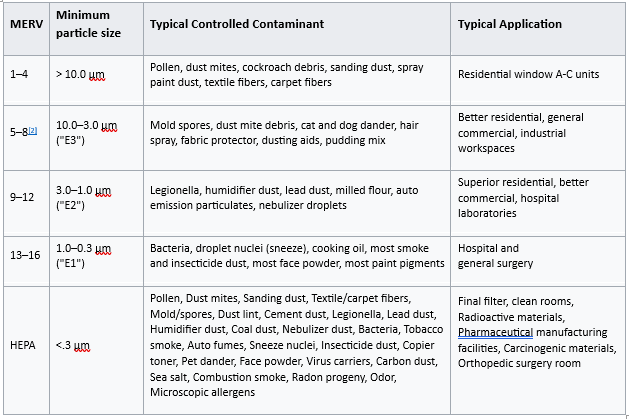The MERV Rating is a measurement scale designed by the American Society of Heating, Refrigerating and Air-Conditioning Engineers (ASHRAE) to report the effectiveness of air filters in more detail than other ratings. The scale is designed to represent the worst-case performance of a filter when dealing with particles in the range of 0.3 to 10 micrometers.
The MERV Rating is a value that’s helpful to reference when comparing the performance of different filters. The higher the MERV rating the better the filter is at trapping specific types of particles; higher MERV rating values correspond to a greater percentage of particles captured on each pass, with a MERV 16 filter capturing more than 95% of particles over the full range.
Quick Summary
MERV stands for Minimum Efficiency Reporting Value (MERV). MERV Rating is a scale to report the effectiveness of air filters in more detail than other ratings.
The MERV Rating is a value that’s helpful to reference when comparing the performance of different filters.
The higher the MERV rating the better the filter is at trapping specific types of particles – this doesn’t necessarily mean higher = better. The MERV rating that is best, is often the one that works best with the building’s HVAC system in place. Indoor Air Quality can be supplemented with portable HEPA filters.
MERV Rating Chart
 10.0 μm Pollen, dust mites, cockroach debris, sanding dust, spray paint dust, textile fibers, carpet fibers Residential window A-C units 5–8[2] 10.0–3.0 μm (“E3”) Mold spores, dust mite debris, cat and dog dander, hair spray, fabric protector, dusting aids, pudding mix Better residential, general commercial, industrial workspaces 9–12 3.0–1.0 μm (“E2”) Legionella, humidifier dust, lead dust, milled flour, auto emission particulates, nebulizer droplets Superior residential, better commercial, hospital laboratories 13–16 1.0–0.3 μm (“E1”) Bacteria, droplet nuclei (sneeze), cooking oil, most smoke and insecticide dust, most face powder, most paint pigments Hospital and general surgery HEPA
10.0 μm Pollen, dust mites, cockroach debris, sanding dust, spray paint dust, textile fibers, carpet fibers Residential window A-C units 5–8[2] 10.0–3.0 μm (“E3”) Mold spores, dust mite debris, cat and dog dander, hair spray, fabric protector, dusting aids, pudding mix Better residential, general commercial, industrial workspaces 9–12 3.0–1.0 μm (“E2”) Legionella, humidifier dust, lead dust, milled flour, auto emission particulates, nebulizer droplets Superior residential, better commercial, hospital laboratories 13–16 1.0–0.3 μm (“E1”) Bacteria, droplet nuclei (sneeze), cooking oil, most smoke and insecticide dust, most face powder, most paint pigments Hospital and general surgery HEPA
Understanding the MERV Rating Chart
Once you understand MERV rating system – you can decide the best MERV air filter for residential HVAC system and/or living environment. MERV rating scales are an industry standard, it allows for the individual to compare filters based on elimination of a particular particle size.
The MERV scale is a range of numerical values ranging from 1 to 20 points – 1 being large particles and 20 being the small particles.
The highest MERV ranking means the filter captures the most particles while the lowest rating means the filter traps the smallest amount of particles. The MERV chart measures the filter’s effectiveness against particles of a specific size range.
In addition to numerical values the MERV rating chart uses a percent to indicate the chance a filter would capture particles of various sizes depending upon micron diameter. The Environmental Protection Agency also has a chart/explainer on MERV ratings, found here.
MERV Ratings and Efficiency
Using air filters with MERV ratings below or above what your manufacturer recommends will likely affect your HVAC unit or HVAC equipment. Small pores in high quality air filters create airflow barriers which can lower system effectiveness and reduce indoor air quality by causing strain on the fan and the system’s fan. Therefore – it’s ideal to leverage a MERV filter that is recommended by the manufacturer.
This concept may indicate choosing a MERV rating and air filter that is appropriate for your HVAC system then including portable HEPA air filters throughout the house for additional improvement in indoor air quality.
Are MERV Filters and HEPA Filters the Same?
No, not exactly – HEPA air filters are a type of filter that can be found at the end of the spectrum on the MERV rating scale above. The HEPA filter is an efficient filter capturing particle sizes between 0.3 micron in diameter. MERV ratings for HEPA filtering range between 16 and 20.
HEPA Air Filter Discussion
HEPA is a type of pleated mechanical air filter. It is an acronym for “high efficiency particulate air (filter)” (defined by the U.S. Dept. of Energy). This type of air filter can theoretically remove at least 99.97% of dust particles, pollen, mold, bacteria, pet dander, and any airborne particles with a size of 0.3 microns (µm).
The diameter specification of 0.3 microns corresponds to the worst case; the most penetrating particle size (MPPS). Particles that are larger or smaller are trapped with even higher efficiency. Using the worst case particle size results in the worst case efficiency rating (i.e. 99.97% or better for all particle sizes).
MERV Filter Ratings and Air Quality
Researchers in Indian communities examined how air filtration can influence air quality in indoor areas. Several research studies have shown that filter air improves the microvascular function and improves other types of arterial function among healthy adult people in addition to improving the lung function of indigenous communities (source).
Frequently Asked Questions on MERV Ratings –
Which MERV Air Filter Rating Should You Use in Your Home?
The best MERV filter to use is the highest rating that is compatible with your building or home’s HVAC system. Ideally – the best filter offers excellent airflow while removing most pollen spores and dust mites.
In most situations, when the MERV rating of the air filter is too high—the HVAC system will be forced to work harder to circulate the air. During an extended period of operation your heating and cooling unit will use more power and begin to wear.
Here are some additional notes on MERV filters (reiterating previous points) –
When replacing filters regularly, its best to use a MERV filter rating of 7-8. Generally, an air filter has two types of structures, pleated and non-pleated. Pleated filters usually have higher MERV ratings and non-pleated filters have lower ratings. A filter with a MERV rating of 8 blocks traps most household particles using a mesh construction. This is typically the favorite pleated air filter because it’s available in most sizes.
A higher MERV rated air filter allows the removal of more particulate matter.
To filter out infectious airborne particles, ASHRAE recommends that organizations use MERV-13 or the highest achievable filtration level, though MERV-14 (or better) is preferred. If going for these ratings – please evaluate the HVAC system parameters.
What is the best MERV rating to use?
Again – similar to the above, the best MERV rating to use is the one that is most compatible with the HVAC system. Depending on your air filtration needs, the are filters available in many sizes.
Quick breakdown –
Lower end MERV filter scores range from 0 to 8 and can filter most large particles. A filter with an efficiency score of 1 – 6 is capable of dispersing particles in the range from 0.3 to 0.5 micron with an efficiency of 20%. The solution is effective at removing particles of small size. These filters have been used in industrial settings with adequate air flow and are less likely to remove smaller particles.
If allergies and respiratory issues are of concern – you can choose to increase your minimum efficiency reporting value by 9 – 12.
If a home has a presence of gas, smoke, or a fireplace, a good value to use is 13-15. This rating filter is meant to trap and remove smoke particles.
A rating above 16 is good for hospitals or factories with higher filters (think HEPA).
How to Choose the Best MERV Rating?

A good MERV rating will filter air while allow for optimal airflow within the home. This also affects air filter operation. In the end, the most important factors when choosing a ranking should be air quality and HVAC system parameters. It is sometimes difficult for a person to choose the perfect MERV ratings so we’d suggest using the optimal MERV filter in the HVAC system and supplementing with portable HEPA air filters in high traffic areas in the building or home.
Is a Higher MERV Rating Better?
That’s not usually the case. A higher MERV rating may cause a lower efficiency in airflow. In the long run, this could overwork the HVAC system and ultimately reduce its effectiveness. The resulting conditions also may have an effect on indoor air quality and may place undue wear and tear on the HVAC system.
For example, often a HEPA filter is impractical in residential central HVAC systems due to the large pressure drop the dense filter material causes. Experiments indicate that less obstructive, medium-efficiency filters of MERV 7 to 13 are almost as effective as true HEPA filters at removing allergens within residential air handling units (source).
Does the MERV Rating Affect How Often You Change the Filter?

Yes, MERV ratings affect when and how many times your air filters need changing. High-rated filters usually accumulate dirt much faster and require repeated cleaning or exchanging. If air filters are not maintained or swapped regularly they are likely to get blocked.
Putting it All Together
The MERV rating system is an important factor when selecting air filters. Evaluate your HVAC systems requirements and select the best MERV rating based on filtration and airflow needs. Do not be afraid to supplement with portable HEPA air filters to improve indoor air quality as air quality is one of the most important factors in overall health.

